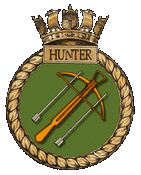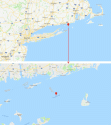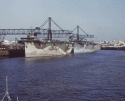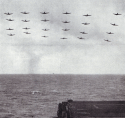NavSource Online: Escort Carrier Photo Archive
BLOCK ISLAND (ACV-8) / HMS HUNTER (D80)
(later CVE-8)

Contributed by Tommy Trampp



| Attacker (US Bogue) Class Escort Carrier | |||||
| Ordered | Laid down | Launched | Commissioned | Returned to US | Stricken |
|---|---|---|---|---|---|
| - | 15 May 1941 | 22 May 1942 | 9 Jan 1943 | 29 Dec 1945 | 26 Feb 1946 |
| Builder: Ingalls Shipbuilding Corp., Pascagoula, Miss. | |||||
| Click On Image For Full Size Image |
Size | Image Description | Contributed By And/Or Copyright |
|
|---|---|---|---|---|
| Name |
||||
 NS0310620 |
177k | AVG-8 was named Block Island for a sound that lies east of Long Island, N.Y., and south of Rhode Island. It takes its name from Block Island which it separates from the Rhode Island coast (NS0310620, courtesy of Google Maps). Transferred to the Royal Navy, she was placed in service as HMS Hunter. A "Hunter" is a person or animal that hunts. The ship's badge features a crossbow, a silent weapon, and was originally designed for the H-class destroyer HMS Hunter (H35). The destroyer was sunk in the First Battle of Narvik, 10 April 1940, and was honored by allocating her name to one of the new escort carriers, which otherwise would have been named Trailer. The design of the badge was transferred from its original shield into a standard, circular shape. (Image courtesy of Tommy Trampp.) |
NavSource | |
 NS0300821 |
10k | |||
| HMS Hunter (D80) |
||||
 NS0300804 |
116k | HMS Trailer, ex-USS Block Island (ACV-8), later HMS Hunter (D80), location unknown, 14 January 1943. (U.S.) Division of Naval Intelligence, Identification and Characteristics Section, June 1943. |
Courtesy of Tony Drury, Royal Navy Escort Carriers | |
 NS0300805 |
88k | Undated picture of the escort carrier HMS Hunter (D80) at anchor at Greenock, Scotland, shortly after commissioning. Photo taken by Lt S. J. Beadell, Royal Navy official photographer. Imperial War Museums, photo # A17693. (Thanks to Robert Hurst for the updated caption.) |
Courtesy of Tony Drury, Royal Navy Escort Carriers | |
 NS0300826 |
11k | The Royal Navy escort carrier HMS Hunter (D80) underway in January 1944, location unknown. Image taken by unknown Royal Navy official photographer. Photo from the official Imperial War Museums Collections, photo # FL10531. |
Robert Hurst | |
 NS0300817 |
41k | HMS Hunter (D80) at anchor at Greenock, Scotland shortly after commissioning. Another escort carrier can be seen in the distance. Photo taken by Lt S. J. Beadell, Royal Navy official photographer. Photo # A 17690 from the collections of the Imperial War Museum. |
Robert Hurst | |
 NS0300811 |
103k | A Supermarine Seafire L.Mk.IIC of No. 807 Sqd. being watched by a crowd of "goofers" as it is taken down to the hangar of the escort aircraft carrier HMS Hunter (D80), date and location unknown. Photo courtesy Rick Harding Collection. Photo and text from Supermarine Seafire by Kev Darling. |
Robert Hurst | |
 NS0300812 |
144k | A Supermarine Seafire L.Mk.IIC (LR642) of No. 807 Sqd ends up in a most undignified position opposite Hunter's island. Close study of this picture reveals that the hook had failed to lower, which indicates that the pilot has actually made a good landing on such a short deck. Photo courtesy Rick Harding Collection. Photo and text from Supermarine Seafire by Kev Darling. |
Robert Hurst | |
 NS0300813 |
62k | A Supermarine Seafire LR.Mk.IIC of No. 807 Sqd that has crash-landed on HMS Hunter's deck. Damage appears to have been restricted to the engine and propeller but the centreline fuel tank has been torn away from its mounting. Photo courtesy Rick Harding Collection. Photo and text from Supermarine Seafire by Kev Darling. |
Robert Hurst | |
 NS0300801 |
49k | Water level image showing her multi level anti-aircraft protection. Seen here at the flight deck level as well as in bulges added to her hull. | IWM | |
NS0300815 |
127k | HMS Hunter (D80) underway, date and location unknown. Pennant number obscured by the censor. |
Courtesy of Tony Drury, Royal Navy Escort Carriers | |
NS0300807 |
53k | Starboard side view of HMS Hunter (D80), ex-HMS Trailer, ex-USS Block Island (CVE-8) at anchor, circa 1943, location unknown. Note Supermarine Walrus amphibian on the flight deck, aft of the bridge. Photo RN, Official. Photo and text from Jane's Fighting Ships, 1943–44 edition. |
Robert Hurst | |
 NS0300828 |
93k | HMS Hunter (D80) arrives in Casablanca ferrying aircraft on 18 March 1943. Note French battleship Jean Bart in the background. LIFE magazine, J.R. Eyerman photographer, shared by Peter DeForest. Used for educational and non-commercial purpose. |
Mike Green | |
 NS0300827 |
274k | "Two off-loading British jeep carriers are seen from USS Nicholson (DD-442) as she gets underway in the Casablanca harbor channel. HMS Hunter (D80) and HMS Stalker (D91) in convoy UGF6 had only arrived hours before on 18 March 1943. The jeeps headed out to Gibraltar the next morning, and Nicholson with photographer Kessel drew screening duty with the approaching convoy UGS6. Photo by Dmitri Kessel, LIFE magazine. Used for educational and non-commercial purpose." |
John Chiquoine | |
 NS0300806 |
60k | HMS Hunter (D80), moored at Greenock, Scotland, 30 June 1943, newly commissioned in the Royal Navy. Imperial War Museums, Admiralty Official Collection, by Beadell, S.J. (Lt), Photo No. ©IWM (A 17691). |
Robert Hurst Larger copy submitted by Mike Green |
|
 NS0300605 |
48k | HMS Battler as seen from HMS Hunter in an angry sea on passage to the Mediterranean for Operation Avalanche at Salerno, Italy (September 1943). Note the overhang of the sponsons from the flight deck catwalk (the Goofers). | Robert Hurst | |
 NS0300814 |
177k | HMS Hunter (D80) underway, 25 June 1944. |
Courtesy of Tony Drury, Royal Navy Escort Carriers | |
NS0300824 |
171k | Tony Drury comments: HMS Hunter (D80): "The key is in the radar fitted above the bridge, Emperor was fitted with type 277 (a parabolic wire dish) above the forward edge of the bridge superstructure, [but this] CVE has a squat 'lantern'-shaped type 271 radar array sat centrally above the radar room in the island superstructure. Also looking at the camouflage markings (as best as can be with the long shot) I think this is Hunter seen during operation Dragoon—the invasion of Southern France in August 1944. This is the only time Emperor and Hunter operated together in the Mediterranean." |
Courtesy of Tony Drury, Royal Navy Escort Carriers | |
 NS0300825 |
187k | HMS Aurora (12) approaching HMS Hunter (D80) for refueling. The ships were part of Force A on 2–4 October 1944 in the Aegean Sea. Imperial War Museums Admiralty official Collection, Oulds, D.C. (Lt.), Photo No. © IWM (A 26009). |
Mike Green | |
 NS0300825a |
147k | HMS Aurora (12) being refueled by HMS Hunter (D80). The ships were part of Force A on 2–4 October 1944 in the Aegean Sea and were off the island of Santorin. HMS Searcher (D40) and HMS Royalist (89) are in the background. Imperial War Museums Admiralty official Collection, Oulds, D.C. (Lt.), Photo No. © IWM (A 26010). |
Mike Green | |
 NS0300809 |
100k | A Supermarine Seafire F.Mk.III of No. 807 Sqd is pictured from the flight deck catwalk of HMS Hunter as it leaves for another patrol[, 1944–45]. Photo courtesy of Rick Harding Collection. Photo and text from Supermarine Seafire by Kev Darling. |
Robert Hurst | |
 NS0300810 |
109k | A Supermarine Seafire F.Mk.III of No.807 Sqd (with debris from its recent dramatic landing scattered around) settles in the classic nose-over pose seen aboard many a escort carrier. Wisely the crew of HMS Hunter are staying clear until the drama is completed. Note the SEAC (South East Asia Command) roundel adopted for service with the British Eastern Fleet. Photo courtesy of Rick Harding Collection. Photo and text from Supermarine Seafire by Kev Darling. |
Robert Hurst | |
 NS0300818 |
419k | Guests posed in front of a Fleet Air Arm Supermarine Seafire LF.Mk.III of No.807 Squadron, aboard HMS Hunter (D80). The image was taken in March 1945, after Hunter had been reunited with No. 807 Squadron at HMS Glebe (Alexandria's pre-war civil airport) and was transiting the Suez Canal to join the British Far East Fleet. Note King Farouk of Egypt (front centre) and senior Egyptian Naval Officers who visited the ship. Imperial War Museums photo # A28114. From Carrier Combat, by David Wragg. |
Robert Hurst | |
 NS0300818a |
306k | Fleet Air Arm Supermarine Seafire L.F.Mk.IIIs of No.807 Squadron aboard the escort carrier HMS Hunter (D80) give a demonstration of formation flying for the Egyptian King who was onboard at this time. From Spitfire: The Story of a Famous Fighter, by Bruce Robertson (Harleyford Publications Ltd., Letchworth, Herts, England.) |
Robert Hurst | |
 NS0300816 |
55k | Three photos of HMS Hunter (D80), ex-Block Island (CVE-8), apparently taken while transiting the Suez Canal, and probably in October 1945. |
David Russell | |
 NS0300816a |
63k | |||
 NS0300816b |
55k | |||
NS0300803 |
49k | HMS Hunter and HMS Empress entering Singapore harbour after the Japanese surrender (September 1945). Note aircraft and ship's company lined up on the flight deck. Two cruisers of the Eastern Fleet are also in harbour. | Robert Hurst | |
 NS0300808 |
121k | The escort aircraft carrier HMS Hunter (D80, ex-USS Block Island, CVE-8), foreground prepares to anchor off Singapore[, September 1945]. The leading aircraft Seafire F.Mk.III (NN300), D-5O, is that of Lt. Cdr. Baldwin. Its camouflage paint has been removed and the aircraft now has silver finish with black SEAC [South East Asia Command] recognition bands and anti-dazzle panel. HMS Stalker (D91, ex-USS Hamlin, CVE-15) can be seen in the background. Photo FAAM Yeovilton. Photo and text from Supermarine Seafire by Kev Darling. |
Robert Hurst | |
| Commercial Service |
||||
 NS0300819 |
52k | SS Almdyk, Holland America Line, date and location unknown. | Tommy Trampp | |
 NS0300820 |
41k | SS Almdyk, Holland America Line, date and location unknown. | Tommy Trampp | |
 NS0300822 |
62k | SS Almdyk, Holland America Line, date and location unknown. | Tommy Trampp | |
 NS0300823 |
71k | Archive photo of ex-HMS Hunter (D80) as Almdyk in Holland-America Lines colors, circa early 1950s. Source: Unknown. |
Gerhard Mueller‑Debus | |
 NS0300829 |
675k | Ex-HMS Hunter (D80), formerly American Block Island (CVE-8), already rebuilt as SS Almdyk, circa early 1950s. |
©The World Ship Society, via Gerhard Mueller‑Debus |
|
 NS0300802 |
64k | Holland America Line Almdyk taking on cargo for the Far East. Bremerhaven, March 1965. | Photo by Gerhard Mueller-Debus | |
|
||||
| Crew Contact and Reunion Information Web Sites | ||||||||||||||||
|
| Related Links |
|
Hazegray & Underway World Aircraft Carrier Pages By Andrew Toppan. HMS Hunter @ Royal Navy Escort Carriers web site |
| Main Photo Index |
Escort Carrier Photo Index Page |
Comments, Suggestions or Image submissions, E-mail Carrier Information
Problems and site related matters, E-mail Webmaster
This page was created by Paul Yarnall and is maintained by Fabio Peña
![]()
Last update: 17 April 2021